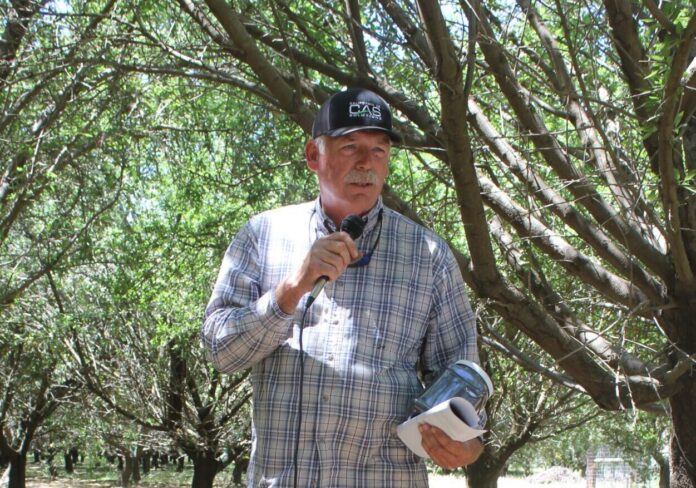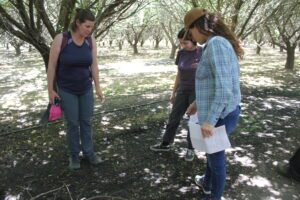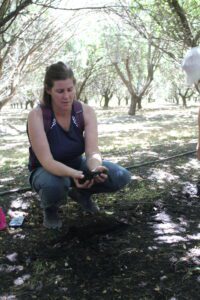
Biochar, a dark, dusty product of pyrolysis, is not exactly a crop nutrient, but a form of soil amendment that is applied and tilled into the soil, serving as a catalyst to improve nutrient access and soil health.
Biochar application rates and its effects on soil health are the focus of an ongoing multi-year trial in a Madera-area almond orchard. UC researchers, partnered with American Farmland Trust and Pacific Farming Company, are seeking to quantify the benefits of biochar use in permanent crops.
Matt Angell of Pacific Farming Company in Madera said the trial was initiated to look at biochar’s ability to reduce soil compaction and hold soil moisture and nutrients where trees can benefit while producing more yield per acre.
At a recent workshop held at the site of the Pacific Farming Company trial, Paul Lum, California senior agriculture specialist with AFT, said the trial’s aim is to show predictable responses in soil health and productivity with different application rates. The workshop was the first of three planned for the site with the next scheduled for fall. The trial will wrap up in 2025.
According to the U.S. Biochar Initiative, biochar applications can increase soil moisture, microbial activity, pH, soil organic carbon and nutrient uptake. It may also decrease nutrient leaching, nitrogen volatilization, soil compaction and greenhouse gas emissions. These impacts may be dependent on soil type, biochar feedstock type, plant nutrient requirements and other environmental factors.
Biochar is created by heating biomass, such as orchard waste, or almond shells at 500 to 700 degrees C in a process called pyrolysis. The result is a black, chalky substance that varies in particle size.
At the Pacific Farming Company 85-acre trial orchard, effects of different applications rates, method of application, placement of application and timing are being studied, and data over the length of the trial is being collected.

Feedstocks Make a Difference
The feedstocks used to make biochar will determine its value in improving soil. Biochar made from woody feedstocks, such as prunings and tree removals of almond shells, has a lower nutrient content than biochar made from manures. Biochar for the Pacific Farming trial is being produced at Corigin Solutions, a large-scale Merced facility that uses both shells and woody biomass.
Biochar, Lum noted, is stable in the soil and carbon-negative, meaning more is sequestered in the soil than is emitted into the atmosphere. It can be a component in soil health that improve structure, aeration, infiltration and retention in orchard soils.
“It is not charcoal, it is not fertilizer.” Lum said. It is also not a form of compost, although blending compost with biochar at a rate of 5% to 10% significantly activates microbial activity in the soil. Applications have been shown to improve soil structure, aeration, infiltration and retention.
Adding biochar to orchard soils may reduce fertilizer needs, save on water and contribute to long-term orchard sustainability and productivity, Lum said. Offsetting those costs with biochar would be a return on investment, Angell said.
Biochar application rates in the trial ranged from 1 to 10 tons per acre, with one ton being identified as the lowest effective rate.
Lum said biochar application timing is best suited to spring, but in the trial it made the most sense to apply it post-harvest. After application, light tilling was done to incorporate the biochar into the top 2 inches of soil. A compost spreader was used to make the application.

Data Collection
Rebecca Ryals, a UC Merced agroecologist, is leading the biochar trial with a goal of collecting new data on soil health indicators. She said soil samples were taken prior to application to establish a baseline. Biochar was broadcast at different rates over the entire are of the plot, not just the berm or row middles, Ryals said, because they were also looking at possible reduction in soil compaction in the middles along with infiltration rates.
Ryals emphasized there are unknown effects with biochar applications. One possible effect is tying up N in the soil and/or affecting nitrogen use efficiency. Biochar is a persistent form of carbon, and knowing the type and baseline conditions in the soil is important.
Harol Gonzales Gallardo with AFT said it is important to incorporate biochar into the soil. In the trials, it has been broadcast and injected as a slurry in fertigation. Different forms of biochar can be applied, including pelletized biochar. Although not part of this trial, he said prior to planting trees, biochar can be trenched along the tree rows. Getting the biochar down deeper in the soil in established plantings is difficult and would require specialized equipment.
He noted there are some safety concerns with biochar applications. Self-ignition, experienced in a small percentage of biochar products, is one concern. In the presence of oxygen, some biochar products may begin to smoke or combust. Adding water to biochar and incorporating it into the soil as soon as possible will prevent self-ignition, he said. Dry leaves on the ground and low humidity can be contributing factors.
Clayton Lynch with AgraLife, a by-products marketing company, said how biochar gets into the ground is a crucial component in its ability to affect soil health. Combining it with compost, he suggested, makes a more efficient application. It does the best in the root zone, he said, but it should be placed where it will be wet.
Particle size of the biochar can also make a difference. Biochar, processed to ‘Rice Krispie’ cereal size fits in with most compost systems. Finer sizes are best but will increase the cost.
One of the ways suggested to make biochar less expensive is to use a mobile pyrolysis machine that can make biochar on-site. Aaron Van Klabern, a local grower who spoke at the workshop, reported on his experience with a mobile machine. The mobile machine, basically an air curtain burner, can make 7 to 8 tons of biochar per hour, processing orchard removals at the rate of five trees per hour.
This is a solution to offset cost of biochar, he said, but the issue with the mobile unit is the materials used to make it did not hold up over time.
“If they make a better machine, I would do it again.”

Cecilia Parsons | Associate Editor
Cecilia Parsons has lived in the Central Valley community of Ducor since 1976, covering agriculture for numerous agricultural publications over the years. She has found and nurtured many wonderful and helpful contacts in the ag community, including the UCCE advisors, allowing for news coverage that focuses on the basics of food production.
She is always on the search for new ag topics that can help growers and processors in the San Joaquin Valley improve their bottom line.
In her free time, Cecilia rides her horse, Holly in ranch versatility shows and raises registered Shetland sheep which she exhibits at county and state fairs during the summer.















